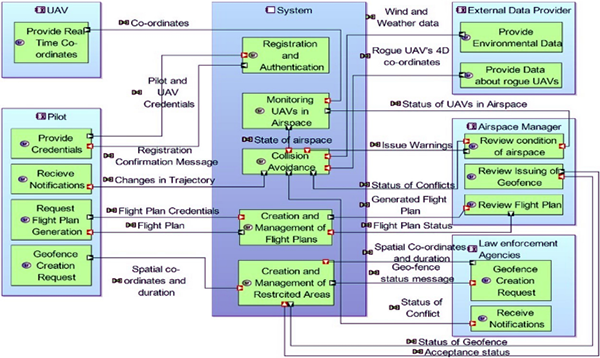The Civil Aviation Ministry notified a traffic management policy framework for drones., i.e. National Unmanned Aircraft System (UAS) Traffic Management (UTM) policy framework, on 24 October 2021.
The policy framework has been drafted by the National UTM Committee constituted by the Central Government. It has been drafted under the overarching framework of the Drone Rules, 2021.
The policy framework is expected to be dynamic and will evolve based on technological advancements, actual experiences and other developments in airspace management systems.
Key Highlights
This policy framework defines the architecture and mechanism for traffic management of unmanned aircraft in Very Low Level (VLL) airspace up to 1000 feet above ground level.
This airspace shall be defined as UTM Airspace. All drones except nano category operating in green zones must use UTM for real-time location sharing. Drone pilots must use UTM services to seek permissions, manage UAS Operations (fleet) and access other UTM services.
The framework envisages private, third-party service providers for ensuring safe operations. UTM Service Providers (UTMSP) are an essential and integral part of DigitalSky Ecosystem. The UTMSPs will extend automated, algorithm-driven software services instead of voice communication as in the traditional Air Traffic Management (ATM) systems.
They will primarily be responsible for segregating and separating a drone from other drones and manned aircraft in the airspace below 1,000 feet in the country.
The traffic management providers will be assisted by Supplementary Service Providers (SSPs), who will maintain data about terrain, weather, location of manned aircraft and provide services such as insurance, data analytics and drone fleet management.
The drone traffic management policy also requires integration of UTM with ATM so that flight plans and real-time location of manned aircraft can be recorded as well in order to continuously separate manned and unmanned aircraft from each other.
Law enforcement and security agencies will also have access to some information in the UTM ecosystem on a need-to-know basis.
The policy also allows UTMSPs to levy a service fee on users, a small portion of which will also be shared with the Airports Authority of India. Following which an evaluation process will be undertaken and successful participants will be awarded regions for establishment of UTM services. UTMSPs will be deployed in small areas to begin with and their geographic presence may be increased subsequently.
C-UAS systems will need to interface with UTM for identifying whether an unmanned aircraft system detected by the C-UAS system is a friend or foe.
The key stakeholders are:
The Central Government.
The Directorate General of Civil Aviation (DGCA).
Bureau of Civil Aviation Security (BCAS).
Airspace Management Agencies.
Air Traffic Control (ATC) Authority.
Air Defence Authority.
UAS Traffic Management Service Providers (UTMSP).
Supplementary Service Providers (SSP).
Remote pilot, law enforcement and security agencies, and general public.
Comments
With a vision to make India a global hub of drones by 2030 under the Atmanirbhar Bharat Abhiyan, the Central Government has carried out a series of reform measures. It notified the liberalised Drone Rules, 2021 on 25th August 2021 and published the drone airspace map on 24th September 2021. To promote manufacturing of drones and drone components in India it notified the Production Linked Incentive (PLI) scheme on 30th September 2021. The single-window digital sky platform is being developed in line with the new Drone Rules, 2021 and is expected to be fully ready by 26th January 2022.
The number of unmanned aircraft operating in the Indian airspace is expected to increase multifold. The interplay between manned and unmanned aircraft has to be managed with utmost attention to global safety norms. India’s UAS Traffic Management systems shall play a vital role in doing so.


















